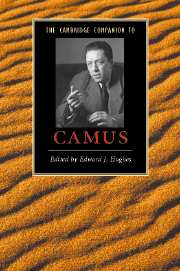Book contents
- Frontmatter
- Introduction
- PART I: BIOGRAPHY AND INFLUENCES
- PART II: THEMES, PREOCCUPATIONS AND GENRES
- PART III: TEXTS AND CONTEXTS
- 11 From Noces to L’Etranger
- 12 Layers of meaning in La Peste
- 13 Withheld identity in La Chute
- 14 Le Premier Homme and the literature of loss
- Postface
- Guide to Further reading
- Index
- Series List
12 - Layers of meaning in La Peste
from PART III: - TEXTS AND CONTEXTS
Published online by Cambridge University Press: 28 September 2007
- Frontmatter
- Introduction
- PART I: BIOGRAPHY AND INFLUENCES
- PART II: THEMES, PREOCCUPATIONS AND GENRES
- PART III: TEXTS AND CONTEXTS
- 11 From Noces to L’Etranger
- 12 Layers of meaning in La Peste
- 13 Withheld identity in La Chute
- 14 Le Premier Homme and the literature of loss
- Postface
- Guide to Further reading
- Index
- Series List
Summary
'Deuxième série: le monde de la tragédie et l'esprit de révolte' (CI, 229) ('Second series: the world of tragedy and the spirit of revolt') (NI, 193), wrote Camus in April 1941, and the scattered notes and sheets of what was to become La Peste acquired further shape and context. Having completed the cycle of 'the Absurd', in a France torn by war and enemy occupation, Camus had for some time been convinced that 'Si ignoble que soit cette guerre, il n'est pas permis d'être en dehors' (CI, 167) ('However vile this war may be, no one can stand aside from it' (NI, 139)). Such a conviction is at work throughout Camus's second cycle, which includes La Peste (1947), the essay L'Homme révolté (1951) and the plays L'Etat de siège (1948) and Les Justes (1949). In keeping with this cycle's exploration of tragedy and revolt, La Peste chronicles the imprisonment, exile, oppression and suffering experienced by the citizens of Oran when a plague strikes. Yet the novel also dramatises the victory of human spirit and solidarity over that which would threaten and dismember it: a plague, an enemy occupation, existence itself. In alluding to such varied forms of oppression, Camus asserted, referring to his experience of the German occupation: 'Je veux exprimer au moyen de la peste l'étouffement dont nous avons tous souffert et l'atmosphère de menace et d'exil dans laquelle nous avons vécu' (CII, 72) ('I want to express by means of the plague the stifling air from which we all suffered and the atmosphere of threat and exile in which we lived' (NII, 53)). Yet, he went on - announcing the text's various layers of meaning and their dynamic oscillation between event and abstraction, literal and figurative meaning, chronicle and allegory - 'Je veux du même coup étendre cette interprétation à la notion d'existence en général' (CII, 72) ('I want at the same time to extend that interpretation to the notion of existence in general' (NII, 53)).
- Type
- Chapter
- Information
- The Cambridge Companion to Camus , pp. 165 - 177Publisher: Cambridge University PressPrint publication year: 2007
- 6
- Cited by

